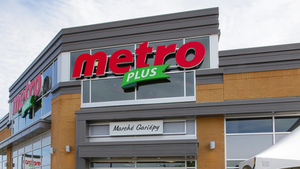MAXMIN'S MAXIMS
"The first thing to stress is that the problems you're experiencing in food distribution, and in the food industry, are not unique to your industry." Words of small comfort coming from outside the industry, or is there a lesson to be had?Maybe the latter, judging by the experiences of James Maxmin as he described them at last week's Midyear Executive Conference of the National-American Wholesale Grocers'
September 19, 1994
David Merrefield
"The first thing to stress is that the problems you're experiencing in food distribution, and in the food industry, are not unique to your industry." Words of small comfort coming from outside the industry, or is there a lesson to be had?
Maybe the latter, judging by the experiences of James Maxmin as he described them at last week's Midyear Executive Conference of the National-American Wholesale Grocers' Association in Colorado Springs. (News coverage of the NAWGA event is on Pages 1 and 39 of this issue.)
Such words might be interesting enough from the "misery loves company" perspective, but they become more instructive from the perspective of experiences gained from James Maxmin's most recent post, that of chief executive officer -- and chief turnaround architect -- at Laura Ashley Holdings in the United Kingdom. Laura Ashley is a vendor of English-style country designs and fabrics.
James Maxmin told the story of how the company was salvaged through a strategic-change program that involved spinning off distribution and distribution systems to a third-party provider. Problems emerged at Laura Ashely, he told NAWGA, as complexity compounded over time. At one time, Laura Ashley was a small but unusually complex company operating in 31 countries with 540 shops. It was managed by a hierarchy of 27 strategic business units, each expected to be a profit center and each pushing costs upstream. Through the 1980s, Laura Ashley crept toward unprofitability, then tipped completely into the red in the late 1980s, at which time James Maxmin's efforts began.
The company was completely changed by means of a strategic alliance with Federal Express, an alliance so total that representatives from Federal Express sat on Laura Ashley's board. Together, the companies developed bar-code-based information systems and distribution methods that allowed the tracking of "every meter of cloth sold by Laura Ashley." Using Federal Express' distribution system, a network of 70 Laura Ashley warehouses worldwide was reduced to a single warehouse in just four months. The remaining warehouse is in Wales and nearly any point in the world could be served from it in 48 hours. The system moved Laura Ashley to nearly total fulfillment; this compares with an out-of-stock rate of 25% previously. And, the system returned the company to a healthy cash flow, largely driven by the same customer base, which increased transaction levels as service improved.
"Relinquishing distribution makes it possible to focus on the company's core competence -- in Laura Ashley's instance, design and merchandising." In all, he said, successful change-driven companies have these characteristics, none of which have much to do with logistics: · They are strategically led: "They have strategies that are crystal clear to everyone in the organization, clear enough so exercises such as re-engineering can be seen as a part of the development of the vision."
· They are competitively focused: "They understand the moves of the competition and are focused on competitors to ensure they always remain out in front. This is like a poker game. You have to throw so much into the pot just to remain in the game."
· They are market oriented: "They are driven by the consumer, but in distribution the consumer isn't just outside the business, it's within the business, the internal consumer."
· They are employee driven: "Decision-making is driven down to the point where problems arise. Don't allow complexity to come up in the business. This is possible with information technology."
· They operate excellently: "There is almost an obsession now with operational excellence and driving out cost. But in the next century, excellence will be a hygiene factor: If you don't have it, you won't be there. But if you do have it, so will everyone else."
About the Author
You May Also Like




